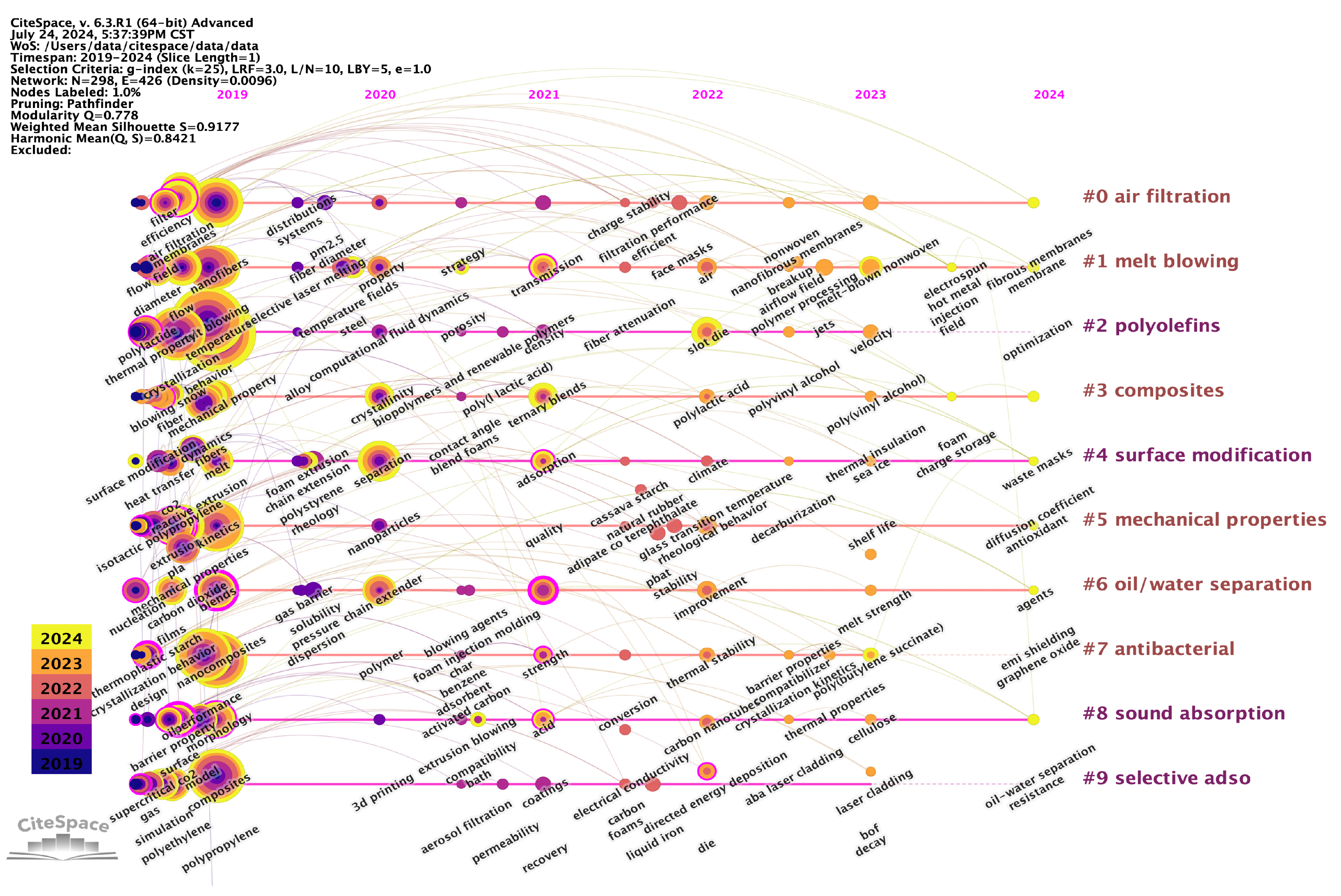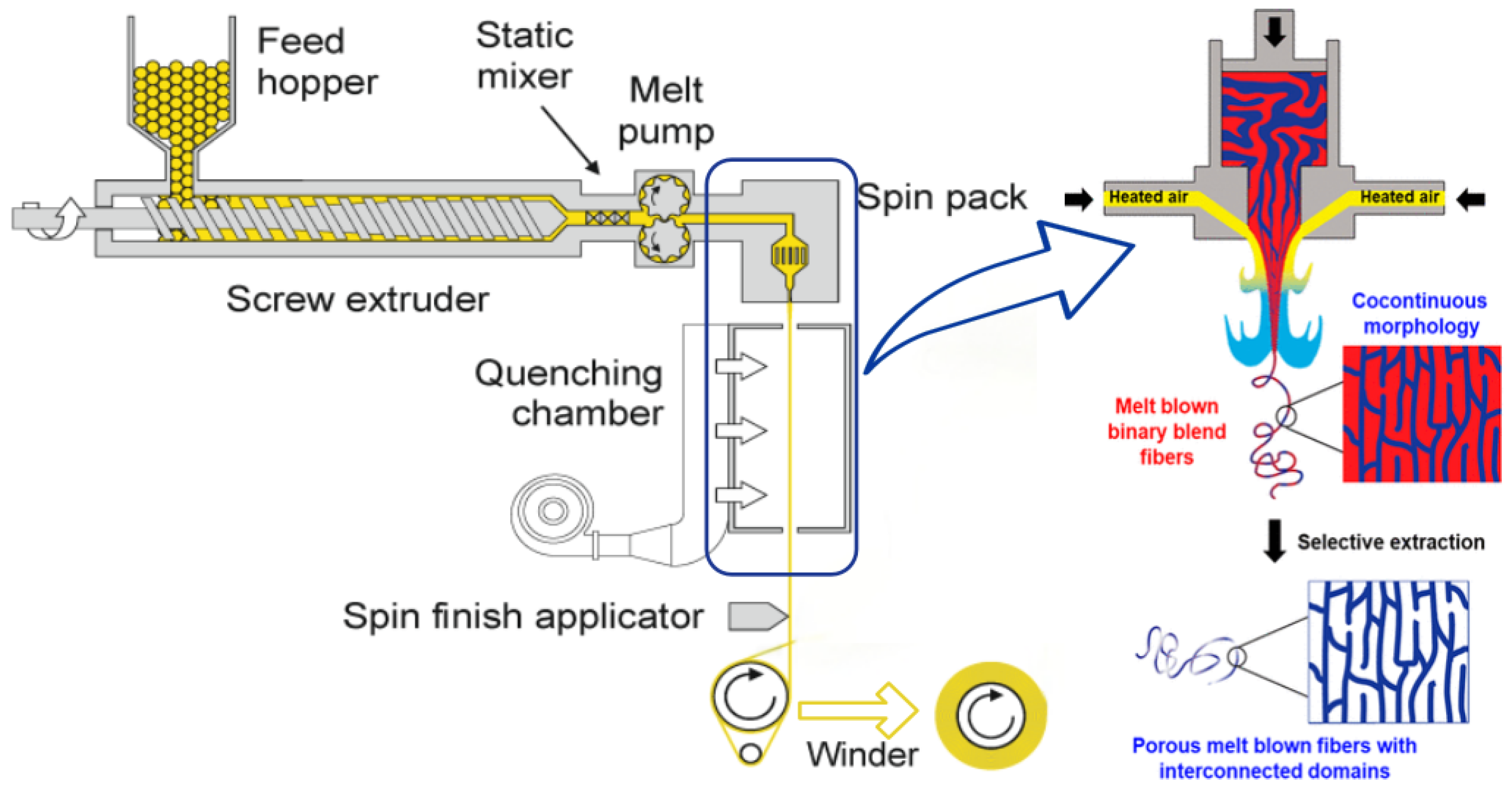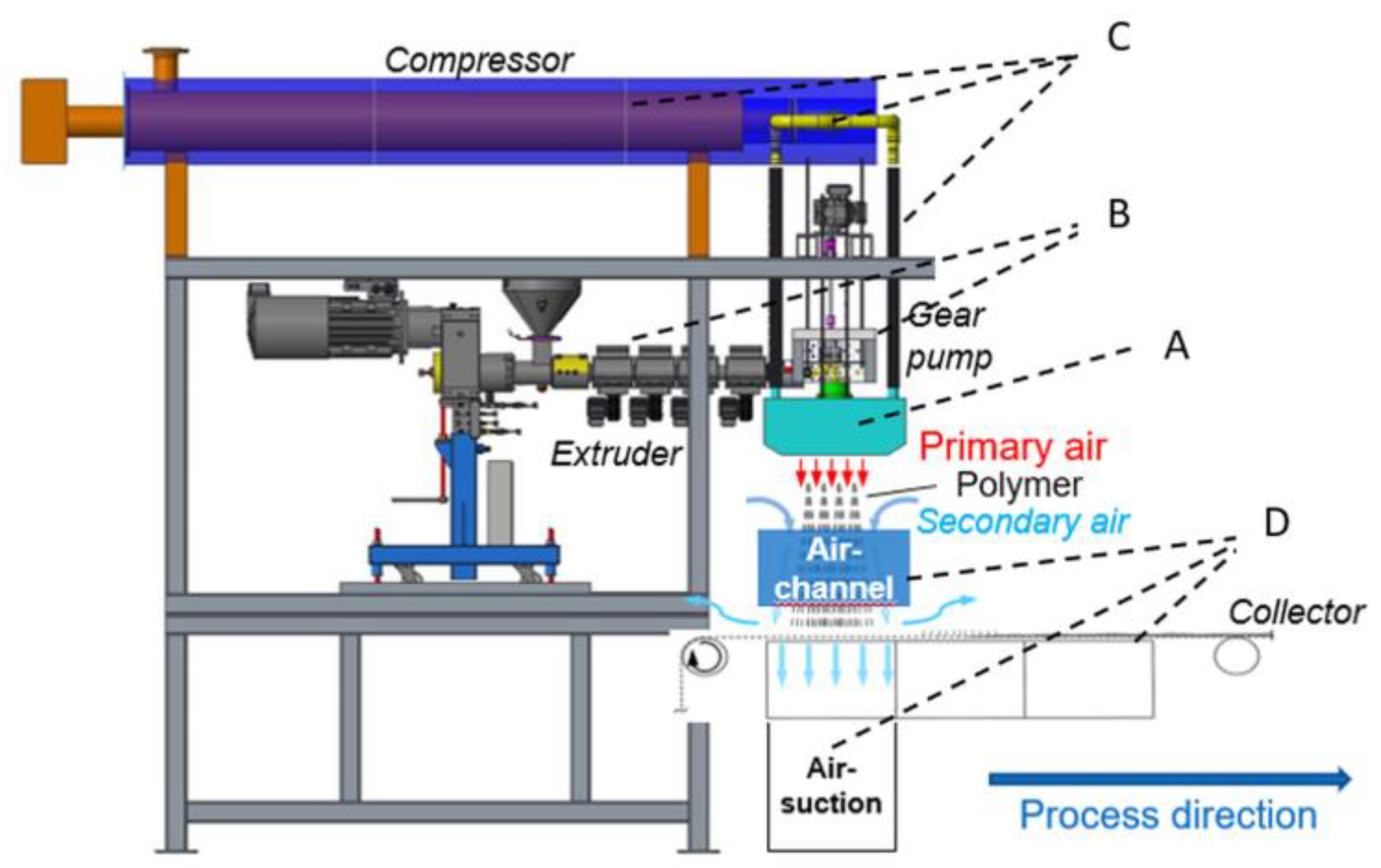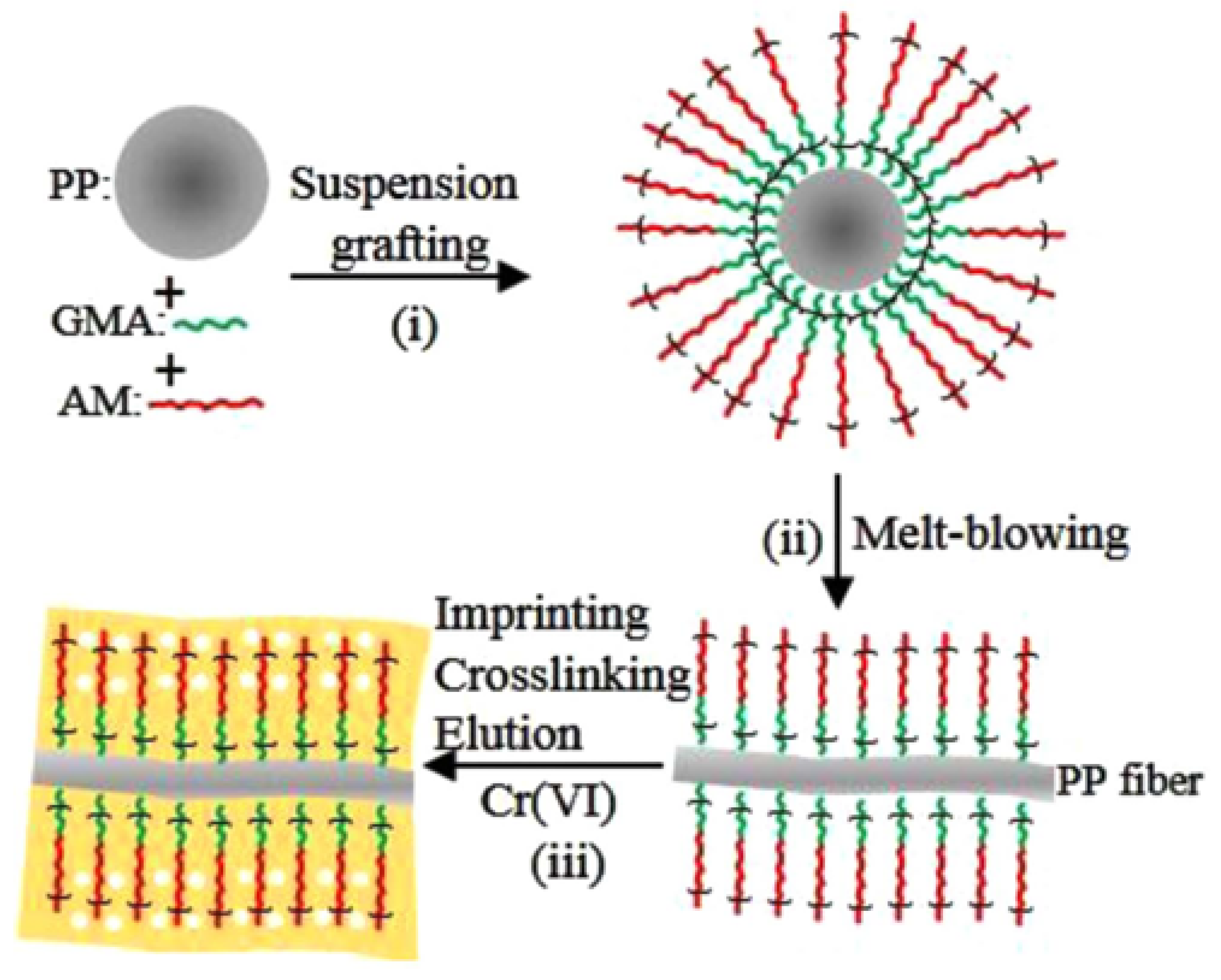Advancements in Research and Applications of PP-Based Materials Utilizing Melt-Blown Nonwoven Technology
Abstract
1. Introduction
2. Melt-Blown Spinning Principles and Processes Description
3. Research Progress of Polypropylene-Based Melt-Blown Nonwoven Materials
3.1. Raw Materials
3.2. Development of Melt-Blown Manufacturing Technology
3.2.1. Bicomponent Melt-Blown Technology
3.2.2. Melt-Blown Electret Technology
3.2.3. Intercalated Melt-Blown Technology
3.2.4. Nanoval Split Spinning Technology
3.3. Applications of Polypropylene-Based Melt-Blown Nonwoven Material
3.3.1. Filter Material
3.3.2. Oil Absorbent Material
3.3.3. Heavy Metal Ions Adsorption
3.3.4. Organic Pollutant Removal
3.3.5. Medical and Health Material
3.3.6. Sound Absorbing Material
3.3.7. Battery Separator Material
4. Conclusions and Outlooks
Author Contributions
Funding
Conflicts of Interest
References
- Wang, P.; Roschli, A.; Paranthaman, M.; Theodore, M.; Cramer, C.; Zangmeister, C.; Zhang, Y.; Urban, J.; Love, L. Recent developments in filtration media and respirator technology in response to COVID-19. MRS Bull. 2021, 46, 822–831. [Google Scholar] [CrossRef] [PubMed]
- Wang, W.; Lu, C. Visualization analysis of big data research based on Citespace. Soft Comput. 2019, 24, 8173–8186. [Google Scholar] [CrossRef]
- Hufenus, R.; Yan, Y.; Dauner, M.; Kikutani, T. Melt-Spun Fibers for Textile Applications. Materials 2020, 13, 4298. [Google Scholar] [CrossRef]
- Sun, G.; Han, W.; Wang, Y.; Xin, S.; Yang, J.; Zou, F.; Wang, X.; Xiao, C. Overview of the Fiber Dynamics during Melt Blowing. Ind. Eng. Chem. Res. 2022, 61, 1004–1021. [Google Scholar] [CrossRef]
- Hao, X.; Zeng, Y. A Review on the Studies of Air Flow Field and Fiber Formation Process during Melt Blowing. Ind. Eng. Chem. Res. 2019, 58, 11624–11637. [Google Scholar] [CrossRef]
- Meng, L.; Zou, F.; Chen, M.; Li, Y.; Wang, Y.; Sun, X.; Wang, X. Crystallization and Mechanical Properties of the Polylactide Melt Blown Nonwovens. Fibers Polym. 2023, 24, 3101–3114. [Google Scholar] [CrossRef]
- Meng, K.; Wang, X.; Chen, Q. Effects of Spinneret Orifice’s Diameter and Polymer Density on Melt Blown Fabrics. Int. J. Nonlinear Sci. Numer. Simul. 2010, 11, 315–316. [Google Scholar] [CrossRef]
- Chang, L.; Zhou, Y.; Dai, K.; Jiang, L.; Jerrams, S.; Ma, J.; Chen, S. The effect of process parameters on the properties of elastic melt blown nonwovens: Air pressure and DCD. J. Appl. Polym. Sci. 2023, 140, e53308. [Google Scholar] [CrossRef]
- Zhang, Y.; Wang, H.; Xu, Z.; Gao, Y.; Zou, Z.; Zhu, F.; Wang, L.; Yang, X. Influence of melt-blown process parameters on the mechanical properties of polylactic acid nonwovens. J. Adv. Text. Eng. 2024, 2, 33–40. [Google Scholar] [CrossRef]
- Li, Z.; Zhao, Z.; Jia, G.; Hu, Z.; Xiang, H.x.; Zhu, M. Performance Analysis and Melt-Blown Research of High Melting Index Polyethylene. Synth. Fiber China 2023, 11, 1–6. [Google Scholar]
- Yesil, Y.; Bhat, G. Structure and mechanical properties of polyethylene melt blown nonwovens. Int. J. Cloth. Sci. Technol. 2016, 28, 780–793. [Google Scholar] [CrossRef]
- Xia, Y.; Li, L.; Luo, Z.; Zhu, Q.; He, L. Preparation and properties of recycled polyethylene non-woven fabrics based on flash evaporation. China Plast. 2022, 36, 14–18. [Google Scholar] [CrossRef]
- Kanai, T.; Kohri, Y.; Takebe, T. Theoretical analysis of the spunbond process and its applications for polypropylenes. Adv. Polym. Tech. 2018, 37, 2085–2094. [Google Scholar] [CrossRef]
- Shabani, A.; Al, G.; Berri, N.; Castro-Dominguez, B.; Leese, H.; Martinez-Hernandez, U. Electrospinning Technology, Machine Learning, and Control Approaches: A Review. Adv. Eng. Mater. 2025, 27, 2401353. [Google Scholar] [CrossRef]
- Hassan, M.; Yeom, B.; Wilkie, A.; Pourdeyhimi, B.; Khan, S. Fabrication of nanofiber meltblown membranes and their filtration properties. J. Membr. Sci. 2013, 427, 336–344. [Google Scholar] [CrossRef]
- Podgórski, A.; Bałazy, A.; Gradoń, L. Application of nanofibers to improve the filtration efficiency of the most penetrating aerosol particles in fibrous filters. Chem. Eng. Sci. 2006, 61, 6804–6815. [Google Scholar] [CrossRef]
- Banerji, A.; Jin, K.; Mahanthappa, M.; Bates, F.; Ellison, C. Porous Fibers Templated by Melt Blowing Cocontinuous Immiscible Polymer Blends. ACS Macro Lett. 2021, 10, 1196–1203. [Google Scholar] [CrossRef]
- Zhang, L.; Yin, R.; Tan, J.; Hou, Q.; Li, C.; Yang, T.; Yang, W.; Li, H. Research progress in nonwoven technology of polyethylene ultrafine fibers. China Plast. 2025, 39, 100–105. [Google Scholar] [CrossRef]
- Xue, Z.; Zhu, D.; Shan, M.; Wang, H.; Zhang, J.; Cui, G.; Hu, Z.; Gordon, K.; Xu, G.; Zhu, M. Functional separator materials of sodium-ion batteries: Grand challenges and industry perspectives. Nano Today 2024, 55, 102175. [Google Scholar] [CrossRef]
- Zhao, B. Numerical simulation the air jet flow field of a dual slot inset blunt die in the melt blowing nonwoven process. Polym. Eng. Sci. 2018, 58, 1817–1825. [Google Scholar] [CrossRef]
- Su, X.; Jia, C.; Xiang, H.; Zhu, M. Research progress in preparation, properties, and applications of medical protective fiber materials. Appl. Mater. Today 2023, 32, 101792. [Google Scholar] [CrossRef] [PubMed]
- Liu, N.; Li, Y.; Xie, D.; Zeng, Q.; Xu, H.; Ge, M.; Zhang, W.; Zhang, Y.; Liu, R.; Dai, J.; et al. UV stabilizer intercalated layered double hydroxide to enhance the thermal and UV degradation resistance of polypropylene fiber. Polym. Test. 2023, 121, 107979. [Google Scholar] [CrossRef]
- Srikhao, N.; Kasemsiri, P.; Srichiangsa, N.; Souvanh, M.; Kidtang, S.; Jarernboon, W.; Okhawilai, M.; Uyama, H.; Chindaprasirt, P. Modification of melt-blown polypropylene filters with spent green tea-mediated green synthesis of nanosilver for antibacterial activities and air purification. Res. Chem. Intermed. 2024, 50, 4965–4981. [Google Scholar] [CrossRef]
- Eticha, A.; Akgul, Y.; Pakolpakcil, A.; Unlu, O.; Ahmed, S.; Cug, H.; Kilic, A. Biodegradable Biconstituent Melt-Blown Nonwovens for Air Filtration: Fabrication and Characterization. Fibers Polym. 2024, 25, 2855–2873. [Google Scholar] [CrossRef]
- Qin, Y.; Jiang, H.; Luo, Z.; Geng, W.; Zhu, J. Preparation and Performance Study of Boron Adsorbent from Plasma-Grafted Polypropylene Melt-Blown Fibers. Polymers 2024, 16, 1460. [Google Scholar] [CrossRef]
- Lam, M.; Baudoin, M.; Mougin, B.; Falentin-Daudre, C. Melt-Blown Polypropylene Membrane Modification for Enhanced Hydrophilicity. J. Biomed. Mater. Res. B Appl. Biomater. 2024, 112, e35509. [Google Scholar] [CrossRef]
- Xie, S.; Fang, Z.; Lian, Z.; Luo, Z.; Zhang, X.; Ma, S. A Novel, Dual-Initiator, Continuous-Suspension Grafting Strategy for the Preparation of PP-g-AA-MAH Fibers to Remove of Indigo from Wastewater. Polymers 2024, 16, 2144. [Google Scholar] [CrossRef]
- Peng, M.; Jia, H.; Jiang, L.; Zhou, Y.; Ma, J. Study on structure and property of PP/TPU melt-blown nonwovens. J. Text. Inst. 2018, 110, 468–475. [Google Scholar] [CrossRef]
- Eticha, A.; Akgul, Y.; Pakolpakcil, A.; Unlu, O.; Cug, H.; Kilic, A. Fabrication of stretchable and high-filtration performance melt-blown nonwoven webs for PM0.3 aerosol filtration. J. Appl. Polym. Sci. 2024, 141, 55297. [Google Scholar] [CrossRef]
- Ma, T.; An, Y.; Zhang, J.; Wen, Z.; Lian, D.; Lu, J.; Wang, H. Structural and Performance Effects of Self-Assembled Composite Antibacterial Additives on PP Melt-Blown Nonwovens Based on Melt Reaction Extrusion. J. Appl. Polym. Sci. 2024, 142, 56610. [Google Scholar] [CrossRef]
- Shen, Y.; Deng, X.; Feng, H.; Gong, R.; Ren, L.; Wang, Y.; Zhang, Y.; Du, W.; Zhang, M. Crystallization behaviours regulations and thermostability enhancement strategy of polypropylene composites modified by dispersed rice husk charcoal. J. Polym. Res. 2024, 31, 190. [Google Scholar] [CrossRef]
- Sun, C.; Zhang, D.; Liu, Y.; Xiao, R. Preliminary study on fiber splitting of bicomponent meltblown fibers. J. Appl. Polym. Sci. 2004, 93, 2090–2094. [Google Scholar] [CrossRef]
- Zhou, Y.; Jiang, L.; Jia, H.; Xing, X.; Sun, Z.; Chen, S.; Ma, J.; Jerrams, S. Study on Spinnability of PP/PU Blends and Preparation of PP/PU Bi-component Melt Blown Nonwovens. Fibers Polym. 2019, 20, 1200–1207. [Google Scholar] [CrossRef]
- Pan, Z.; Liu, G.; Chen, X.; Babar, A.; Dong, Y.; Wang, X. Water electret charging based polypropylene/electret masterbatch composite melt-blown nonwovens with enhanced charge stability for efficient air filtration. J. Text. Inst. 2022, 113, 2128–2134. [Google Scholar] [CrossRef]
- Fatihou, A.; Zouzou, N.; Dascalescu, L. Particle Collection Efficiency of Polypropylene Nonwoven Filter Media Charged by Triode Corona Discharge. IEEE Trans. Ind. Appl. 2017, 53, 3970–3976. [Google Scholar] [CrossRef]
- Larsen, G.S.; Cheng, Y.; Daemen, L.L.; Lamichhane, T.; Hensley, D.K.; Hong, K.; Meyer, H.M.; Monaco, S.J.; Levine, A.M.; Lee, R.J.; et al. Polymer, Additives, and Processing Effects on N95 Filter Performance. ACS Appl. Polym. Mater. 2021, 3, 1022–1031. [Google Scholar] [CrossRef]
- Liu, C.; Dai, Z.; He, B.; Ke, Q. The Effect of Temperature and Humidity on the Filtration Performance of Electret Melt-Blown Nonwovens. Materials 2020, 13, 4774. [Google Scholar] [CrossRef]
- Chen, C.; Chen, G.; Zhang, J.; Lin, Y.; Yu, Y.; Gao, X.; Zhu, L. Study on corona charging characteristic of melt-blown polypropylene electret fabrics. J. Electrost. 2023, 121, 103782. [Google Scholar] [CrossRef]
- Zhang, J.; Chen, G.; Zhou, Z.; Huang, C.; Wang, Z.; Chen, C.; Ma, T.; Liu, P. Correlation of antibacterial performance to electrostatic field in melt-blown polypropylene electret fabrics. J. Electrost. 2022, 115, 103675. [Google Scholar] [CrossRef]
- Zhang, X.; Liu, J.; Zhang, H.; Hou, J.; Wang, Y.; Deng, C.; Huang, C.; Jin, X. Multi-Layered, Corona Charged Melt Blown Nonwovens as High Performance PM Air Filters. Polymers 2021, 13, 485. [Google Scholar] [CrossRef]
- Zhao, Y.; Zhang, Y.; Ju, J.; Qian, Z.; Cui, X.; Wang, S.; Cheng, B.; Kang, W. Stearate and hindered amine light stabilizers coordinate to boost charge storage performance of water electret melt-blown nonwovens. Sep. Purif. Technol. 2024, 332, 125729. [Google Scholar] [CrossRef]
- Han, L.; Hu, M.; Ma, Y.; Hao, D. Research of medical nonwoven mask materials and its new technology. J. Xi’An Polytech. Univ. 2020, 34, 20–25. [Google Scholar] [CrossRef]
- Feng, J.; Li, R.; Wang, J.; Wu, C. Study on Intercalated Melt-blown Nonwovens Based on Product Performance Control Mechanism. Highlights Sci. Eng. Technol. 2023, 69, 566–575. [Google Scholar] [CrossRef]
- Chen, E. Research on Performance Control of Intercalated Melt-blown Nonwoven Materials. J. Phys. Conf. Ser. 2023, 2562. [Google Scholar] [CrossRef]
- Höhnemann, T.; Schnebele, J.; Arne, W.; Windschiegl, I. Nanoval Technology—An Intermediate Process between Meltblown and Spunbond. Materials 2023, 16, 2932. [Google Scholar] [CrossRef]
- Periyasamy, A.; Luoma, E.; Höhnemann, T.; Ringger, S.; Heikkilä, P. Investigate the Processability of Biobased Thermoplastics Used in Nonwoven Fabrics. ACS Polym. Au 2024, 4, 405–419. [Google Scholar] [CrossRef]
- Xu, H.; Yagi, S.; Ashour, S.; Du, L.; Hoque, M.; Tan, L. A Review on Current Nanofiber Technologies: Electrospinning, Centrifugal Spinning, and Electro-Centrifugal Spinning. Macromol. Mater. Eng. 2023, 308, 2200502. [Google Scholar] [CrossRef]
- Lin, X.; Sun, W.; Lin, M.; Chen, T.; Duan, K.; Lin, H.; Zhang, C.; Qi, H. Bicomponent core/sheath melt-blown fibers for air filtration with ultra-low resistance. RSC Adv. 2024, 14, 14100–14113. [Google Scholar] [CrossRef]
- Zhao, Y.; Zhang, S.; Kang, W.; Wang, S.; Li, Y. Preparation of PBT@PP-CNC@cellulose wood pulp paper double-layers fuel filtration materials with high efficiency and high dust holding capacity. J. Mater. Sci. 2024, 59, 5622–5633. [Google Scholar] [CrossRef]
- Wang, X.; Chen, C.; Li, Z.; Wang, X. Preparation of binder-free composite filters material and their efficient removal of slag powder. J. Water Process. Eng. 2024, 63, 105527. [Google Scholar] [CrossRef]
- Zhang, J.; Wang, L.; Zhang, C.; Long, X.; Zheng, Y.; Zuo, Y.; Jiao, F. MnOx-mineralized oxidized-polypropylene membranes for highly efficient oil/water separation. Sep. Purif. Technol. 2021, 276, 119343. [Google Scholar] [CrossRef]
- Li, M.; Dai, Z.; Huang, C.; Ke, Q.; Gu, L. Preparation and Filtration Performance of PTFE Membrane/Bi-component Melt-Blown Nonwoven Composite Filter Material. J. Donghua Univ. (Nat. Sci. Ed.) 2018, 44, 174–181. [Google Scholar] [CrossRef]
- Zhao, L.; Yang, Y.; Wang, Y.; Yan, Z.; Zhang, R. Preparation of Double-Layer Composite Coffee Filtration Nonwovens. Polymers 2024, 16, 2275. [Google Scholar] [CrossRef] [PubMed]
- Uppal, R.; Bhat, G.; Eash, C.; Akato, K. Meltblown nanofiber media for enhanced quality factor. Fibers Polym. 2013, 14, 660–668. [Google Scholar] [CrossRef]
- Sun, F.; Zheng, Y.; Liu, E.; Chen, T.; Xiao, Q. Three-dimensional multi-scale membrane for efficient air filtration performances: Preparation, optimization and characterization. J. Polym. Res. 2024, 31, 75. [Google Scholar] [CrossRef]
- Zakaria, M.; Shibahara, K.; Bhuiyan, A.; Nakane, K. Preparation and characterization of polypropylene nanofibrous membrane for the filtration of textile wastewater. J. Appl. Polym. Sci. 2022, 139, 52657. [Google Scholar] [CrossRef]
- Zhang, H.; Zhen, Q.; Yan, Y.; Guan, X.; Liu, R.; Liu, Y. Polypropylene/polyester composite micro/nano-fabrics with linear valley-like surface structure for high oil absorption. Mater. Lett. 2020, 261, 127009. [Google Scholar] [CrossRef]
- Alassod, A.; Abedalwafa, M.; Xu, G. Evaluation of polypropylene melt blown nonwoven as the interceptor for oil. Environ. Technol. 2021, 42, 2784–2796. [Google Scholar] [CrossRef]
- Sokolovic, S.; Kiralj, A.; Sokolovic, D.; Jokic, A. Application of waste polypropylene bags as filter media in coalescers for oily water treatment. Hem. Ind. 2019, 73, 147–154. [Google Scholar] [CrossRef]
- Luo, Q.; Li, F.; Zhen, W.; Ge, Q.; Zhou, Y.; Ma, C.; Sun, P.; Xu, J.; Chen, B. Preparation and adsorption behavior investigation of polypropylene/organically modified saponite nanocomposites fiber membrane with strong oil-adsorption. Polym. Eng. Sci. 2024, 64, 2439–2458. [Google Scholar] [CrossRef]
- Tang, Z.; Sun, Y.; Xie, Y.; Chen, G.; Sun, H.; Yu, B. Preparation of CoAl-LDH@M-PP MB Composite Melt-blown Materials and Their Adsorption and Separation Properties. Acta Polym. Sin. 2025, 56, 611–622. [Google Scholar] [CrossRef]
- Sun, Y.; Sun, H.; Yu, B.; Yang, X.; Xu, T. Preparation of CCO@M-PP MB for Oil–Water Separation. Fibers Polym. 2024, 25, 725–735. [Google Scholar] [CrossRef]
- Chen, H.; Guo, M.; Yao, X.; Luo, Z.; Dong, K.; Lian, Z.; Wei, W. Green and Efficient Synthesis of an Adsorbent Fiber by Plasma-induced Grafting of Glycidyl Methacrylate and Its Cd(II) Adsorption Performance. Fibers Polym. 2018, 19, 722–733. [Google Scholar] [CrossRef]
- Liu, C.; Jia, J.; Liu, J.; Liang, X. Hg selective adsorption on polypropylene-based hollow fiber grafted with polyacrylamide. Adsorpt. Sci. Technol. 2017, 36, 287–299. [Google Scholar] [CrossRef]
- Chen, R.; Zhao, C.; Bai, M.; Li, T. Study of Graft Copolymerization on Polypropylene Fiber and Its Adsorption Behaviors. J. Shenyang Univ. Chem. Technol. 2010, 24, 6. [Google Scholar] [CrossRef]
- Guo, M.; Chen, H.; Luo, Z.; Lian, Z.; Wei, W. Selective Removal of Pb(II) Ions from Aqueous Solutions by Acrylic Acid/Acrylamide Comonomer Grafted Polypropylene Fibers. Fibers Polym. 2017, 18, 1459–1467. [Google Scholar] [CrossRef]
- Luo, Z.; Li, L.; Guo, M.; Jiang, H.; Geng, W.; Wei, W.; Lian, Z. Water-solid Suspension Grafting of Dual Monomers on Polypropylene to Prepare Ion-imprinted Fibers for Selective Adsorption of Cr(VI). Fibers Polym. 2020, 21, 2729–2739. [Google Scholar] [CrossRef]
- Luo, Z.; Chen, H.; Xu, J.; Guo, M.; Lian, Z.; Wei, W.; Zhang, B. Surface grafting of styrene on polypropylene by argon plasma and its adsorption and regeneration of BTX. J. Appl. Polym. Sci. 2018, 135, 46171. [Google Scholar] [CrossRef]
- Werner, L.; Nowak, B.; Jackiewicz-Zagórska, A.; Gołofit-Szymczak, M.; Górny, R. Functionalized zinc oxide nanorods - polypropylene nonwoven composite with high biological and photocatalytic activity. J. Environ. Chem. Eng. 2023, 11, 21. [Google Scholar] [CrossRef]
- Lian, Z.; Xu, Y.; Zuo, J.; Qian, H.; Luo, Z.; Wei, W. Preparation of PP-g-(AA-MAH) Fibers Using Suspension Grafting and Melt-Blown Spinning and its Adsorption for Aniline. Polymers 2020, 12, 2157. [Google Scholar] [CrossRef]
- Li, B.; Dong, Y. Coordination Kinetics of Different Carboxylic Fiber with Fe3+ and Catalytic Degradation Performance of Their Fe3+ Complexes. Chem. J. Chin. Univ. Chin. 2014, 35, 1761–1770. [Google Scholar] [CrossRef]
- Liu, Y.; Sun, H.; Wang, J.; Yu, B. Preparation of TiO2/MIL-88B(Fe)/polypropylene composite melt-blown nonwovens and study on dye degradation properties. J. Text. Res. 2020, 41, 95–102. [Google Scholar] [CrossRef]
- Wang, W.; Shen, C.; Shao, R.; Zhu, Y.; Yu, W.; Wu, X.; Huang, W.; Li, K.; Xu, Z. One-step in situ growth of heterojunction carbon dots-TiO2/ZIF-8 on the surface of meltblown fibers: Towards recyclable photocatalysts for degradation of organic dyes. Colloids Surfaces Physicochem. Eng. Asp. 2025, 714, 136568. [Google Scholar] [CrossRef]
- Zhang, D.; Sun, H.; Yu, B.; Xie, Y.; Li, F. Preparation of MnO2@PP MB for Organic Dyes Removal. Fibers Polym. 2025, 26, 1251–1264. [Google Scholar] [CrossRef]
- EN 14683:2019; Medical Face Masks—Requirements and Test Methods. European Committee for Standardization (CEN): Brussels, Belgium, 2019.
- Dellweg, D.; Lepper, P.; Nowak, D.; Köhnlein, T.; Olgemöller, U.; Pfeifer, M. Stellungnahme der DGP zur Auswirkung von Mund-Nasenmasken auf den Eigen- und Fremdschutz bei aerogen übertragbaren Infektionen in der Bevölkerung. Pneumologie 2020, 74, 331–336. [Google Scholar] [CrossRef]
- Gericke, A.; Venkataraman, M.; Militky, J.; Steyn, H.; Vermaas, J. Unmasking the Mask: Investigating the Role of Physical Properties in the Efficacy of Fabric Masks to Prevent the Spread of the COVID-19 Virus. Materials 2021, 14, 7756. [Google Scholar] [CrossRef]
- Čepič, G.; Gorjanc, D. Influence of the Web Formation of a Basic Layer of Medical Textiles on Their Functionality. Polymers 2022, 14, 2258. [Google Scholar] [CrossRef]
- Jeong, S.; Hwang, Y.; Yi, S. Antibacterial properties of padded PP/PE nonwovens incorporating nano-sized silver colloids. J. Mater. Sci. 2005, 40, 5413–5418. [Google Scholar] [CrossRef]
- Liu, C.; Shi, J.; Luo, F.; Zhang, X. Preparation, characterization and antibacterial properties of hydro-charged melt-blown nonwovens coated with an N-halamine. New J. Chem. 2024, 48, 19355–19363. [Google Scholar] [CrossRef]
- Ma, Y.; Wisuthiphaet, N.; Bolt, H.; Nitin, N.; Zhao, Q.; Wang, D.; Pourdeyhimi, B.; Grondin, P.; Sun, G. N-Halamine Polypropylene Nonwoven Fabrics with Rechargeable Antibacterial and Antiviral Functions for Medical Applications. ACS Biomater. Sci. Eng. 2021, 7, 2329–2336. [Google Scholar] [CrossRef]
- Wu, R.; Song, M.; Sui, D.; Duan, S.; Xu, F.J. A natural polysaccharide-based antibacterial functionalization strategy for liquid and air filtration membranes. J. Mater. Chem. B 2022, 10, 2471–2480. [Google Scholar] [CrossRef] [PubMed]
- Kubacka, A.; Ferrer, M.; Cerrada, M.; Serrano, C.; Sánchez-Chaves, M.; Fernández-García, M.; Álvarez, A.; Jiménez-Rivero, R.; Fernández-Martín, F.; Fernández-García, M. Boosting TiO2-anatase antimicrobial activity: Polymer-oxide thin films. Appl. Catal. B-Environ. 2009, 89, 441–447. [Google Scholar] [CrossRef]
- Alcaraz, M.; Bonet-Aracil, M.; Sanchís, E.; Alcaraz, J.; Seguí, I. Textiles in architectural acoustic conditioning: A review. J. Text. Inst. 2021, 113, 166–172. [Google Scholar] [CrossRef]
- Markiewicz, E.; Borysiak, S.; Paukszta, D. Polypropylene-lignocellulosic material composites as promising sound absorbing materials. Polimery 2009, 54, 430–435. [Google Scholar] [CrossRef]
- Sivri, C.; Haji, A. Surface Coating of Needle-Punched Nonwovens with Meltblown Nonwovens to Improve Acoustic Properties. Coatings 2022, 12, 1092. [Google Scholar] [CrossRef]
- Liu, J.; Bao, W.; Shi, L.; Zuo, B.; Gao, W. General regression neural network for prediction of sound absorption coefficients of sandwich structure nonwoven absorbers. Appl. Acoust. 2014, 76, 128–137. [Google Scholar] [CrossRef]
- Soltani, P.; Azimian, M.; Wiegmann, A.; Zarrebini, M. Experimental and computational analysis of sound absorption behavior in needled nonwovens. J. Sound Vib. 2018, 426, 1–18. [Google Scholar] [CrossRef]
- Bhagat, A.; Pal, R.; Ghosh, A. Foam processability of polypropylene/sisal fiber composites having near-critical fiber length for acoustic absorption properties. Polym. Compos. 2024, 45, 555–568. [Google Scholar] [CrossRef]
- Bhat, G.; Messiry, M. Effect of microfiber layers on acoustical absorptive properties of nonwoven fabrics. J. Ind. Text. 2019, 50, 312–332. [Google Scholar] [CrossRef]
- Shen, J.; Li, X.; Yan, X. Mechanical and Acoustic Properties of Jute Fiber-Reinforced Polypropylene Composites. ACS Omega 2021, 6, 31154–31160. [Google Scholar] [CrossRef]
- Shen, J.; Shao, X.; Li, X.; Zhang, B.; Yan, X. A low-cost and environmental-friendly microperforated structure based on jute fiber and polypropylene for sound absorption. J. Polym. Res. 2022, 29, 397. [Google Scholar] [CrossRef]
- Çelikel, D.; Babaarslan, O. Effect of Bicomponent Fibers on Sound Absorption Properties of Multilayer Nonwovens. J. Eng. Fibers Fabr. 2017, 12, 15–25. [Google Scholar] [CrossRef]
- Çinçik, E.; Aslan, E. Assessing the Sound and Heat Insulation Characteristics of Layered Nonwoven Composite Structures Composed of Meltblown and Recycled Thermo-Bonded Layers. Polymers 2024, 16, 1391. [Google Scholar] [CrossRef] [PubMed]
- Zhang, B.; Hou, Q.; Liu, W.; Liang, Z.; Wang, B.; Zhang, H. Wet-Laid Formation and Strength Enhancement of Alkaline Battery Separators Using Polypropylene Fibers and Polyethylene/Polypropylene Bicomponent Fibers as Raw Materials. Ind. Eng. Chem. Res. 2017, 56, 7739–7746. [Google Scholar] [CrossRef]
- Fan, Y.; Niu, Z.; Zhang, F.; Zhang, R.; Zhao, Y.; Lu, G. Suppressing the Shuttle Effect in Lithium-Sulfur Batteries by a UiO-66-Modified Polypropylene Separator. ACS Omega 2019, 4, 10328–10335. [Google Scholar] [CrossRef]
- Wang, Z.; Zhu, H.; Yang, L.; Wang, X.; Liu, Z.; Chen, Q. Plasma Modified Polypropylene Membranes as the Lithium-Ion Battery Separators. Plasma Sci. Technol. 2016, 18, 424–429. [Google Scholar] [CrossRef]
- Moghim, M.; Nahvibayani, A.; Eqra, R. Mechanical properties of heat-treated polypropylene separators for Lithium-ion batteries. Polym. Eng. Sci. 2022, 62, 3049–3058. [Google Scholar] [CrossRef]
- Liu, H.; Yang, F.; Xiang, M.; Cao, Y.; Wu, T. Development of Multilayer Polypropylene Separators for Lithium-Ion Batteries via an Industrial Process. Ind. Eng. Chem. Res. 2021, 60, 11611–11620. [Google Scholar] [CrossRef]
- Bicy, K.; Kalarikkal, N.; Stephen, A.; Rouxel, D.; Thomas, S. Facile fabrication of microporous polypropylene membrane separator for lithium-ion batteries. Mater. Chem. Phys. 2020, 255, 123473. [Google Scholar] [CrossRef]
- Zhang, C.; Tian, W.; Li, D.; Quan, L.; Zhu, C. The high performances of SiO2-coated melt-blown non-woven fabric for lithium-ion battery separator. J. Text. Inst. 2018, 109, 1254–1261. [Google Scholar] [CrossRef]
- Yuan, Z.; Xue, N.; Xie, J.; Xu, R.; Lei, C. Separator Aging and Performance Degradation Caused by Battery Expansion: Cyclic Compression Test Simulation of Polypropylene Separator. J. Electrochem. Soc. 2021, 168, 030506. [Google Scholar] [CrossRef]
- Zhang, Y.; Li, Y.; Han, C.; Qin, Y.; Zhang, J.; Wu, J.; Gao, J.; Zhu, X. Ultrathin MgB2 nanosheet-modified polypropylene separator for high-efficiency lithium-sulfur batteries. J. Colloid Interface Sci. 2024, 653, 664–672. [Google Scholar] [CrossRef] [PubMed]
- Zhu, W.; Zhang, Z.; Wei, J.; Jing, Y.; Guo, W.; Xie, Z.; Qu, D.; Liu, D.; Tang, H.; Li, J. A synergistic modification of polypropylene separator toward stable lithium-sulfur battery. J. Membr. Sci. 2020, 597, 117646. [Google Scholar] [CrossRef]







Disclaimer/Publisher’s Note: The statements, opinions and data contained in all publications are solely those of the individual author(s) and contributor(s) and not of MDPI and/or the editor(s). MDPI and/or the editor(s) disclaim responsibility for any injury to people or property resulting from any ideas, methods, instructions or products referred to in the content. |
© 2025 by the authors. Licensee MDPI, Basel, Switzerland. This article is an open access article distributed under the terms and conditions of the Creative Commons Attribution (CC BY) license (https://creativecommons.org/licenses/by/4.0/).
Share and Cite
Fang, Z.; Wang, J.; Xie, S.; Lian, Z.; Luo, Z.; Du, Y.; Zhang, X. Advancements in Research and Applications of PP-Based Materials Utilizing Melt-Blown Nonwoven Technology. Polymers 2025, 17, 1013. https://doi.org/10.3390/polym17081013
Fang Z, Wang J, Xie S, Lian Z, Luo Z, Du Y, Zhang X. Advancements in Research and Applications of PP-Based Materials Utilizing Melt-Blown Nonwoven Technology. Polymers. 2025; 17(8):1013. https://doi.org/10.3390/polym17081013
Chicago/Turabian StyleFang, Ziyang, Jie Wang, Sijia Xie, Zhouyang Lian, Zhengwei Luo, Yan Du, and Xueying Zhang. 2025. "Advancements in Research and Applications of PP-Based Materials Utilizing Melt-Blown Nonwoven Technology" Polymers 17, no. 8: 1013. https://doi.org/10.3390/polym17081013
APA StyleFang, Z., Wang, J., Xie, S., Lian, Z., Luo, Z., Du, Y., & Zhang, X. (2025). Advancements in Research and Applications of PP-Based Materials Utilizing Melt-Blown Nonwoven Technology. Polymers, 17(8), 1013. https://doi.org/10.3390/polym17081013





